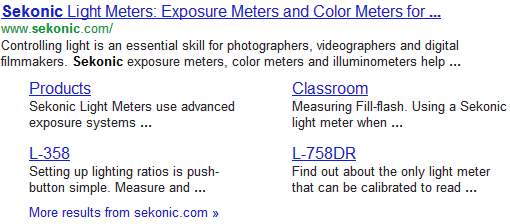What Are Google Sitelinks?
Google sitelinks are a deluxe listing format that presents a main search result, followed by two or more indented Sitelink results. Most web site operators view Sitelinks as a reputation enhancer, and also a way to control a greater area of the search results page. For these reasons Sitelinks are valuable.
Here’s an example of a Sitelinks listing. On a Google search for the keyword “Sekonic” beneath the main search result we see links to various areas of the Sekonic web site. This would help a searcher in two ways: they can get a better understanding of what the site is about before they visit, and they can take a shortcut from Google to the page that interests them, rather than arriving at the home page and then having to navigate.

Google Doesn’t Say How to Get Sitelinks
Google advises webmasters to build sites with clear navigation and a well-planned hierarchy of pages. These features may make a site more amenable to Google’s Sitelink analysis algorithms.
The precise workings of many Google algorithms, including Sitelinks, are kept secret to discourage people from manipulating the rankings, but we can still look at examples and try to understand where Sitelinks come from. I’ve worked on many sites with Sitelinks, and these sites are similar in the following ways:
These factors may, or may not, be exactly what Google uses to trigger Sitelinks. Nevertheless, everything on this list is desirable for a web marketing program, so using the list as a guide would probably make your site more effective.
I’ve also seen problem sites that did not get Sitelinks. Some characteristics that could hinder Sitelinks include:
Signals Used By Google’s Sitelinks Algorithm?
Again, we do not know for sure, but we can deduce some of the signals by looking at Google’s Webmaster Guidelines and by studying the Google Search Engine Results Pages (SERPs). Google’s Webmaster Guidelines say, in the first item under design and content guidelines, “Make a site with a clear hierarchy and text links.” That’s good advice for several reasons. A clear navigation hierarchy is good for visitors and helps search engines understand the topic of each page. Google can’t create Sitelinks if it can’t understand the meaning of the sub-pages, either by analysis or by observing visitor behavior.
We know that Google search results pages (SERPs) contain links with tracking info, and that many users have Google accounts, so Google can watch their behavior over time. Google provides webmasters with Google Analytics free of charge. Google provides the Chrome web browser free of charge. Google isn’t expending resources to do all this tracking, and write all this software, without a return on their investment. We can safely assume that Google will somehow use all that data to improve their search results with features like Sitelinks.
If I were Google, I’d be very interested to know which search results have above-average click through rates for particular keywords. I’d also like to know if searchers were happy with my search results. If too many searchers choose a listing and then return to the SERP, that could indicate a poor quality search result. All this information is collected automatically, providing a scalable way to identify search spam, and the opposite, search “gems.” A search gem with significant search volume would be the ideal candidates for a Sitelinks listing.
How to Improve the Odds of Getting Sitelinks
While we can only make educated guesses, we may as well do things that are also good for Search Engine Marketing (SEM) and user experience. Even if these guesses miss the target, you won’t be wasting effort with these recommendations:
Have questions or want more information? Please contact us today.